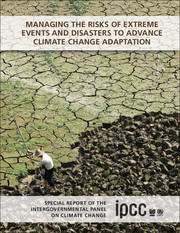 Managing the Risks of Extreme Events and Disasters to Advance Climate Change Adaptation
Managing the Risks of Extreme Events and Disasters to Advance Climate Change Adaptation from Section III
Published online by Cambridge University Press: 05 August 2012
Executive Summary
Disaster signifies extreme impacts suffered when hazardous physical events interact with vulnerable social conditions to severely alter the normal functioning of a community or a society (high confidence). Social vulnerability and exposure are key determinants of disaster risk and help explain why non-extreme physical events and chronic hazards can also lead to extreme impacts and disasters, while some extreme events do not. Extreme impacts on human, ecological, or physical systems derive from individual extreme or non-extreme events, or a compounding of events or their impacts (for example, drought creating the conditions for wildfire, followed by heavy rain leading to landslides and soil erosion). [1.1.2.1, 1.1.2.3, 1.2.3.1, 1.3]
Management strategies based on the reduction of everyday or chronic risk factors and on the reduction of risk associated with non-extreme events, as opposed to strategies based solely on the exceptional or extreme, provide a mechanism that facilitates the reduction of disaster risk and the preparation for and response to extremes and disasters (high confidence). Effective adaptation to climate change requires an understanding of the diverse ways in which social processes and development pathways shape disaster risk. Disaster risk is often causally related to ongoing, chronic, or persistent environmental, economic, or social risk factors. [1.1.2.2, 1.1.3, 1.1.4.1, 1.3.2]
Development practice, policy, and outcomes are critical to shaping disaster risk (high confidence). Disaster risk may be increased by shortcomings in development. Reductions in the rate of depletion of ecosystem services, improvements in urban land use and territorial organization processes, the strengthening of rural livelihoods, and general and specific advances in urban and rural governance advance the composite agenda of poverty reduction, disaster risk reduction, and adaptation to climate change. [1.1.2.1, 1.1.2.2, 1.1.3, 1.3.2, 1.3.3]
To save this book to your Kindle, first ensure [email protected] is added to your Approved Personal Document E-mail List under your Personal Document Settings on the Manage Your Content and Devices page of your Amazon account. Then enter the ‘name’ part of your Kindle email address below. Find out more about saving to your Kindle.
Note you can select to save to either the @free.kindle.com or @kindle.com variations. ‘@free.kindle.com’ emails are free but can only be saved to your device when it is connected to wi-fi. ‘@kindle.com’ emails can be delivered even when you are not connected to wi-fi, but note that service fees apply.
Find out more about the Kindle Personal Document Service.
To save content items to your account, please confirm that you agree to abide by our usage policies. If this is the first time you use this feature, you will be asked to authorise Cambridge Core to connect with your account. Find out more about saving content to Dropbox.
To save content items to your account, please confirm that you agree to abide by our usage policies. If this is the first time you use this feature, you will be asked to authorise Cambridge Core to connect with your account. Find out more about saving content to Google Drive.